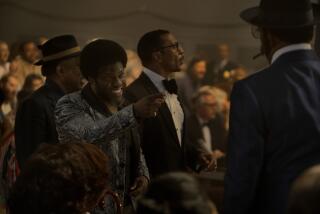Getting Acquainted With ‘January Man’
- Share via
One of the East Coast film observers has announced that the makers of “The January Man” can now relax. Theirs is no longer the worst movie of 1989, he said. “Her Alibi” with Tom Selleck and Paulina Porizkova has taken its place at the bottom of the barrel.
I hear in such dismissive scorn all the accumulated weight of years of disappointment and outrage over movies that attempted too much and failed or, more often, tried too little and even muffed that.
“Her Alibi” has not yet fallen upon my eyes, and I neither confirm nor deny its placement in the barrel. But I saw “The January Man” on a damp noon last weekend, with an industry audience that may simply have been glad to be in out of a cold rain but that laughed a lot and enthusiastically, as I did.
What is true, as has been attested by the East Coast critic and many others, is that “The January Man” contains plot holes of immense size, has astonishing inconsistencies of tone and attack and leaves a curious general impression that the next time they’ll get it right.
But what is also true is that even in its artifices and its incoherences, “The January Man” does offer those laughs and some quite beguiling performances, even if you do leave the theater whistling, “What was that all about?”
The most interesting thing about “January Man” is that it is the third film written by John Patrick Shanley. “Five Corners,” loosely inspired by his boyhood in the Bronx in the 1950s, was quirky, original and not very successful. “Moonstruck” was quirky, original and, of course, hugely successful with (most) critics and audiences. (Shanley won an Oscar for original screenplay.)
“January Man” is nothing if not quirky and original. It is not a rousing success, to say the least of it, but it offers a chance to triangulate on Shanley.
The three scripts are clearly the work of the same idiosyncratic imagination. They have a consistency that, like it or not, is uncommon in film work--or has been since Preston Sturges departed.
Shanley appears to have a unique line on magical Eastern urban realism, a variant of the magical realism found mostly in contemporary Latin-American writers. It is an often paradoxical blending of the observed and the imagined, verisimilitude and wild fancy.
In “Five Corners,” Shanley gave us the unlovely reality of Bronx streets plus a kidnaped penguin, a true psychopath and victims killed by bows and arrows by other persons whose presence was never quite satisfactorily explained. The film, directed by Tony Bill, also had a nice nutty sequence in which young people rode up and down on the tops of elevators.
Weird, all of it, although you could see that a certain amount of less-than-wonderful social truth was being diluted, so to speak, by the improbable, mildly fantastical imaginings.
So it was in “Moonstruck,” which was called “Moonstruck” for good reason. That old mythic moon was left over from Eugene O’Neill and several centuries’ worth of predecessors. The realities of the city streets, double-entry bookkeeping and a sweatshop bakery were ameliorated by characters with one foot in farce and the other on the rim of tragedy.
What “Moonstruck” proved beyond argument was that Shanley has a rare gift for dialogue. I’m not sure that an ear for dialogue is the way to say it. Real speech rarely has the economy, the timing, the polish that Shanley gives his talk. Like the dialogue in John O’Hara’s best short stories, it is a simulation, but the disguise is perfect.
Shanley also has a dramatist’s feeling for scenes--scenes with beginnings, middles and exits. They’re his building blocks, and as assembled by Norman Jewison they gave “Moonstruck” an odd sense of orderliness, no matter how zany the goings-on got to be.
With “The January Man,” you do get the feeling that there is a great cutting-room in the sky someplace where all the missing exposition can be found. The back story never got out of the back room and there are moments when watching “January Man” is like trying to follow the third episode of a miniseries mystery after you’ve missed the first two. It doesn’t matter a great deal, you tell yourself, but what was that business about the check?
Shanley has evidently watched or read a bunch of mysteries himself and taken umbrage at the dazzling intuitions by which the sleuth perceives the pattern that produces the villain. Kevin Kline’s tracking of a serial killer is the reduction to absurdity of all such intuitions, deriving the pattern from the moon, a constellation, a song title and mathematics--and discovering a killer who doesn’t look as if he could find his way to a subway station.
The Shanley gifts for wonderful dialogue and for inventing characters who are poised somewhere between the abnormal and the bizarre remain intact in “January Man.” Danny Aiello, the mother-loving suitor from “Moonstruck,” is on display again as a police chief of profoundly uncertain abilities. Rod Steiger has some richly choleric moments as the mayor of New York.
Like the two earlier films, “January Man” is full of what the Elizabethan poets called conceits, small, glittering and unexpected inventions: wonderful if they work, rather dismal when, as happens here, they don’t. For example, Kline likes to cook meals of repellent unattractiveness for the women he loves, I guess as a test of their faith. But it is a notion that falls flatter than a diseased scrod.
Pat O’Connor, who directed, found a welcome abundance of charm in Kline, even at the script’s most foolish moments. But the melding of a kind of realism with a kind of burlesqued fantasy as demanded in “The January Man” would likely have been a problem for any director.
You are left with some genuine laughter, with a renewed awareness that Shanley is a special and considerable talent, and with an equally renewed feeling that nobody wins ‘em all.
More to Read
Only good movies
Get the Indie Focus newsletter, Mark Olsen's weekly guide to the world of cinema.
You may occasionally receive promotional content from the Los Angeles Times.









